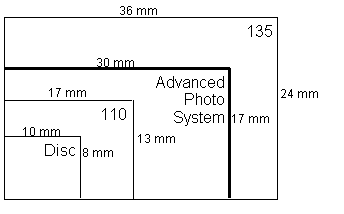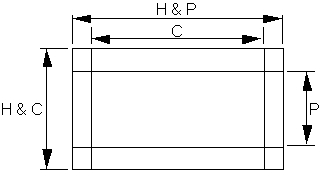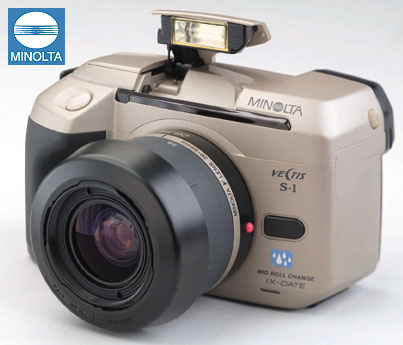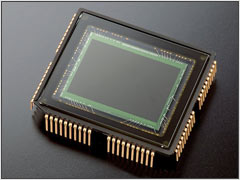Digital Photography from 20,000 Feet
by Wesley Fink on September 25, 2006 12:05 AM EST- Posted in
- Digital Camera
The Digital SLR
Several factors delayed the move to SLR technology for digital photography. First, the early sensors were much lower megapixel resolutions, far too low to begin to compete with film photography. Photo hobbyists saw few advantages to moving to a low resolution system since the reason they used an SLR was high image quality. It wasn't until resolutions reached the 2 to 4 megapixel range that there was any interest in a digital SLR.
Second, the early sensors were very small, developed primarily for video usage. Some tried to develop proprietary systems based on a smaller sensor size with more compact lenses, but nothing caught on in the industry. The cost of early sensors was also astronomical, making the early digital SLR cameras only useful for production, high volume photography where the cost could be justified.
Third, with sensor resolution and size in constant development it was much easier to design a point-and-shoot camera around each new sensor generation. Until sensor size stabilized, a digital SLR that used existing lens systems was not practical.
APS (Advanced Photo System)
35mm first appeared on the scene in the 1930s and the film format simply took 35mm motion picture film and spooled it into a light-tight canister. By the 1960s, with point-and-shoot and developments in SLR technology, 35mm had become king of the film formats. Even as film manufacturers tried to introduce other film formats, 35mm continued to grow and prosper. With the very early developments in digital photography, Kodak, Fuji and others saw the handwriting on the wall for film photography. One of the ongoing complaints about 35mm film, however, has been that the 2:3 image format required image loss in almost every standard print size. 8x10 and 5x7 are neither a 2:3 ratio and both required cropping of the 35mm negative.

In 1996 a new APS (Advanced Photo System) initiative by Kodak, Fujifilm, Minolta, Nikon, Canon and others was introduced to save film by standardizing on new ratios and adding new "computer-like" data storage capabilities in the taking and processing of images. APS included a new film size - 30.2mm x 16.7mm - that could be printed full-frame (H or HDTV format), or use standard crops of 25.1mm x 16.7mm (C or Classic 2:3 format) or 9.5mm x 30.2mm (P or Panorama). Actually, the image size that was always shot was the 30.2mm x 16.7mm, and the other sizes were just standard crops.

The industry was confident they could sell APS, which in the most common C view was only about 55% of the already small 35mm size. Some manufacturers like Minolta developed new APS lens lines with smaller cameras and lenses, and Canon and Nikon developed APS camera bodies that could mount their regular lenses - and a few custom APS lenses.

In the end, APS failed in the film market, but it is important in our discussion of Digital Photography because it was also a standard for digital development. At the time of the APS initiatives, it seemed reasonable to aim for development of digital sensors for that same APS format, so lenses for both systems were interchangeable. The industry aimed for the APS C size sensor, which would be about 16.7mm x 25.1mm the same ratio (2:3) as the classic 35mm format. This allowed existing 35mm lenses to be used, with a lens factor of 1.5 to 1.6, and the development of new lenses with a smaller image circle.
What do we mean by Lens Factor? Why does it matter?
The Lens Factor
APS really doesn't matter in the film market, except as a brief and intense flurry of activity that has produced a huge number of APS cameras in every imaginable format. Some of the high-end models are particularly interesting and will become collectibles. APS cameras like the tiny Minolta Vectis S-1 SLR system, the Canon IX, and Nikon Pronea are remarkably well-built and intelligent designs for the APS format.

The APS may be discontinued and dying in the film market, but it is alive and well in today's Digital SLR market. Today Sony, Nikon, Canon, Pentax, Minolta, Samsung and every other production SLR on the market (except Olympus) uses a sensor that is approximately APS C size. This matters because the lenses designed for 35mm SLR photography do not behave the same when used to capture images with the smaller APS sensor.
Several factors delayed the move to SLR technology for digital photography. First, the early sensors were much lower megapixel resolutions, far too low to begin to compete with film photography. Photo hobbyists saw few advantages to moving to a low resolution system since the reason they used an SLR was high image quality. It wasn't until resolutions reached the 2 to 4 megapixel range that there was any interest in a digital SLR.
Second, the early sensors were very small, developed primarily for video usage. Some tried to develop proprietary systems based on a smaller sensor size with more compact lenses, but nothing caught on in the industry. The cost of early sensors was also astronomical, making the early digital SLR cameras only useful for production, high volume photography where the cost could be justified.
Third, with sensor resolution and size in constant development it was much easier to design a point-and-shoot camera around each new sensor generation. Until sensor size stabilized, a digital SLR that used existing lens systems was not practical.
APS (Advanced Photo System)
35mm first appeared on the scene in the 1930s and the film format simply took 35mm motion picture film and spooled it into a light-tight canister. By the 1960s, with point-and-shoot and developments in SLR technology, 35mm had become king of the film formats. Even as film manufacturers tried to introduce other film formats, 35mm continued to grow and prosper. With the very early developments in digital photography, Kodak, Fuji and others saw the handwriting on the wall for film photography. One of the ongoing complaints about 35mm film, however, has been that the 2:3 image format required image loss in almost every standard print size. 8x10 and 5x7 are neither a 2:3 ratio and both required cropping of the 35mm negative.

In 1996 a new APS (Advanced Photo System) initiative by Kodak, Fujifilm, Minolta, Nikon, Canon and others was introduced to save film by standardizing on new ratios and adding new "computer-like" data storage capabilities in the taking and processing of images. APS included a new film size - 30.2mm x 16.7mm - that could be printed full-frame (H or HDTV format), or use standard crops of 25.1mm x 16.7mm (C or Classic 2:3 format) or 9.5mm x 30.2mm (P or Panorama). Actually, the image size that was always shot was the 30.2mm x 16.7mm, and the other sizes were just standard crops.

The industry was confident they could sell APS, which in the most common C view was only about 55% of the already small 35mm size. Some manufacturers like Minolta developed new APS lens lines with smaller cameras and lenses, and Canon and Nikon developed APS camera bodies that could mount their regular lenses - and a few custom APS lenses.

In the end, APS failed in the film market, but it is important in our discussion of Digital Photography because it was also a standard for digital development. At the time of the APS initiatives, it seemed reasonable to aim for development of digital sensors for that same APS format, so lenses for both systems were interchangeable. The industry aimed for the APS C size sensor, which would be about 16.7mm x 25.1mm the same ratio (2:3) as the classic 35mm format. This allowed existing 35mm lenses to be used, with a lens factor of 1.5 to 1.6, and the development of new lenses with a smaller image circle.
What do we mean by Lens Factor? Why does it matter?
The Lens Factor
APS really doesn't matter in the film market, except as a brief and intense flurry of activity that has produced a huge number of APS cameras in every imaginable format. Some of the high-end models are particularly interesting and will become collectibles. APS cameras like the tiny Minolta Vectis S-1 SLR system, the Canon IX, and Nikon Pronea are remarkably well-built and intelligent designs for the APS format.

The APS may be discontinued and dying in the film market, but it is alive and well in today's Digital SLR market. Today Sony, Nikon, Canon, Pentax, Minolta, Samsung and every other production SLR on the market (except Olympus) uses a sensor that is approximately APS C size. This matters because the lenses designed for 35mm SLR photography do not behave the same when used to capture images with the smaller APS sensor.










81 Comments
View All Comments
feraltoad - Monday, September 25, 2006 - link
Is providing a single sentence regarding start-up time dwelling? I don't think any camera review is complete without listing startup times and listing shot to shot time. I think it's a bit hypocritical to focus on core architecture, timings and such and then say a length of time I can actually perceive is not relevant. Especially, when you go and provide such a good article. I think you are just trying to make the other review sites seem stodgy and backward or just wrongheaded, and show that AT is "with it". Moreover, you say they speak gibberish like they are jargon slinging photo elitist snobs. Then you provide,IMO, a pretty techical primer, when they probably have some material for novices too. I know you were just saying "We're Cool, We Rule!", but I don't think when ur AT you have to do that. AT is already in my RSS reader because it does quality reviews. I just skimmed the article, and I can't wait to go back and read it in depth. I'me really excited about AT doing photo stuff too. I agree with the above poster that finding some standard meaningful benchmarks with good subjective commentary will have AT ruling the roost in camera reviews. Not to plug another site, but I think Steve's Digicams provides excellent reviews, actually his site is about the only site I really find useful for cameras. I'm glad I will soon have two sites that provide good information. YAY AT!soydios - Monday, September 25, 2006 - link
How does AnandTech review and compare its computer components? With standardized benchmarks and editorial commentary. Compare all the cameras with a good, strong set of standardized tests across the board, and also add a dose of the editorial commentary.In particular, for the sub-$1000 market, I would suggest evaluating the kit as a whole (image quality with kit lens). Personally, I will be picking up a Nikon D50 with the 18-55mm and 55-200mm lenses, and I have researched the heck out of that package, trying to find an AnandTech-esque review.
Venturing above the sub-$1000 (although I would be very intrigued by some reviews of the professional-level equipment) would get very expensive very fast. Perhaps start small, then venture into the almost-pro market (Nikon D200 and Canon EOS 30D, and some of the $500-$1000 lenses), then maybe dip a toe into the professional level, just to let us all see what the real fancy stuff is like (since very few of us will be buying a D2Xs or EOS-1D MkII-N).
Time permitting, I would put out some quick looks at the Nikon D50 and the Canon EOS 350D, with some comparison between the two. A review/comparison of both the Nikon D80 (in the works, good!) and the Canon EOS 400D would be an interesting read.
Again, review the D-SLR market the same way you guys do computer hardware. Avoid the slugfest low-range and the stratospherically-priced high range. Focus on the high-midrange market (the sub-$1000 D-SLR's to start, move up to the $1k-2k market once you gain some feel for differences between cameras). Do across-the-board standardized benchmarks, with some synthetic but more real-world results.
mostlyprudent - Monday, September 25, 2006 - link
Exactly my thoughts. I have spent some time at a number of camera review sites and am always left wondering "Is the Nikon D80 good enough to justify the price difference over the D50?". "What about the Canon EOS 30D? How much better is it then the Nikon D80 or the Rebel XT/XTi?"Maybe these cannot be answered in the same way as CPU and GPU articles, but standardized tests and comparisons would be nice.
Give me some numbers! I don't want to hear "shot-to-shot performance was sluggish compared to higher end cameras"...unless you can quantify that for me.
Lighting is such an improtant part of photography. Standardized indoor lighting under a couple different kinds of lighting situation (i.e. low, bright, fluorescent, etc.). I don't know how to standardize outdoor shots, but it sure would be nice.
bigpow - Monday, September 25, 2006 - link
I'm gonna stick with www.dpreview.com for now if I want to get my digital photography news/articles.AT, stick with PCs, will you?
silver - Monday, September 25, 2006 - link
I don't understand as I usually read more than one site on one subject. For instance I've been reading Tomshardware since it was sysdoc.pair.com and both Anandtech and Extremetech nearly as long.jnmunsey - Monday, September 25, 2006 - link
Geez, you'd think a site like Anandtech would find someone who knows what he's talking about to write this article...soydios - Monday, September 25, 2006 - link
I'm just a photography hobbyist, but I thought that the article covered all the important basics of full-manual general photography and digital photography.I would touch on filters, though. Those can come in handy. Particular onces to focus on: UV ("does it actually do anything, or is it just a lens protector?" debate), Polarizing, and the primary colors (blue, yellow, and red).
soydios - Monday, September 25, 2006 - link
Concerning polarizing filters (I really wish there was an edit functionality for comments): circular polarizing works with autofocus and digital cameras, linear does not.I know AnandTech isn't much of a software website, but a short article on editing software (Adobe Photoshop, beta of Adobe Lightroom, Apple Aperture) would complete the picture. No need to focus on the software or printing, but a photography software article written in the same manner as this one is something that would help me a lot! (I have almost no experience with editing software).
Wesley Fink - Monday, September 25, 2006 - link
We all want to improve, so please provide specifics so we can address them. It would also be helpful if you would provide your photography credentials, so we can know the level of expertise to attach to your comments.kilkennycat - Monday, September 25, 2006 - link
... a first-class and technically-meaty summary of the current status of digital camera technology. Well up to the usual Anadtech standards. Congratulations, Wes. The addition of a Digital Camera section is a superb idea. By all means, use reference charts, lighting and scenes for resolution, optical-distortion, shading and color-fidelity comparison of both lenses and sensors. Just as you have with video cards and CPUs, come up with your own benchmarks if necessary.